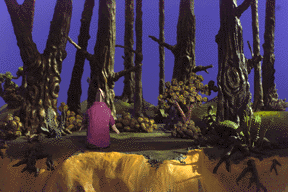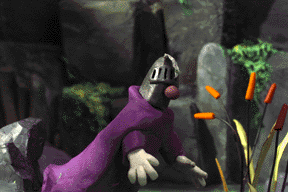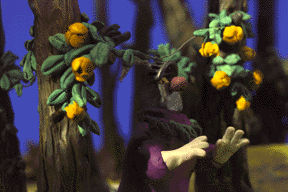by Guionne Leroy

A digital shot from the work-in-progress.
I was born in Belgium in 1967, and studied animation at La Cambre in Brussels from 1987 until 1992. I've made several personal animated short films in clay but only one using computer technology. From 1993 until 1996 I worked in the States on the animated features Toy Story and James and the Giant Peach. However, I came back to Belgium a year ago, due to the chance to pursue some more personal work through a commissioned piece illustrating opera music for the French company Pasavision. This clay animation piece titled Arthur is still in production. We hope it will be finished in September. What is special about the project, however, is that we're using a digital camera.
Arthur, the main character of the film,
is a clay figure.
A Unique Idea
This commissioned work has a tight budget,
which means I must work with a short shooting schedule, a small team, and
no ambitious sets. It was a challenge to come up with rich visuals that
were interesting enough to fulfill the task of illustrating such vibrant
opera music. Then Stéphane Simal, who offered to co-produce the
film, started to talk about an idea he had, about using a digital camera.
This was new to me, as so far I have done all of my works in a traditional
manner using 16mm and 35mm film. Since the images we shot would be directly
entered into the computer, it has opened the doors to infinite possibilities
throughout post-production. Also, I have been able to utilize far more
ambitious visuals than such a budget would normally allow. These are the
aspects that seduced me. For example, my idea required stylish landscapes
that the character could travel in and interact with, but we didn't have
the studio space or the equipment for such large sets. So I shot solely
the foreground against a blue screen and was able to add a 2D painted background
later.
Shooting in front of special
green and blue screens enables
compositing of backgrounds in the computer.
Endless Possibilities
Once the images were stored on CD-ROMs,
we used a Macintosh computer and Adobe's After Effects and Photoshop software
to continue to build the film. These tools allowed me to create a background,
which was a painted sky with moving clouds, or mountains with additional
atmospheric touches like fog and lighting changes. I would never have been
able to accomplish this through traditional animation methods. I was also
able to add finishing touches like motion blur, sparks, shock effects,
and more. Another added bonus was that I could correct mistakes like camera
bumps or displaced props which can otherwise ruin a shot. I also digitally
removed set supports for a sequence with flying butterflies. All of these
kinds of tricks are usually reserved for big budget productions.
I appreciated the fact that when shooting, I could see the day's results
in the form of quick-time movies. I found it a stress-free (almost) and
faster way to work. This, for me, compensates for not being able to look
through a traditional camera lens to view the image. Referring to a monitor
creates a kind of distance that I used to consider inconvenient.
Basically, I found this way of working very exciting because it is so flexible and allows so many possibilities. I found the digital camera to be a great tool to use in conjunction with traditional 3D animation like puppets and clay. In fact, it brought the piece to a quality level hard to achieve without a large budget. Most of all, it really opened the door for me to have more creative freedom and a lot of fun!

Thousands of digital images like these are
stored on CD-ROM for the creation of individual frames in the film.
Guionne Leroy is a Belgian animator who, since completing her education at La Cambre in 1992, has worked on animation productions around the world, including feature films, commercials and commissioned short films.
Table of Contents
Feedback?
Past Issues
![]()
![]()
![]()
![]()
![]()
![]()
[about | help
| home | info@awn.com
| mail | register]
© 1997 Animation World Network